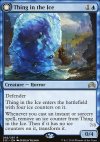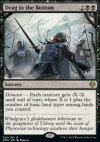|

MV anecdotes
| 4844 anecdotes trouvées |   |
Les cartes Carry Away et Steal Enchantment sont des références à Steal Artifact de par leur nom et/ou leur effet, transposé d'un artefact à respectivement un équipement et un enchantement (voir aussi cette anecdote).
D'une certaine manière les cartes Steal Artifact et Control Magic ont le même effet, appliqué à respectivement un artefact et une créature.
D'une certaine manière les cartes Steal Artifact et Control Magic ont le même effet, appliqué à respectivement un artefact et une créature.
Sur l'illustration de la carte Bouncing Beebles, on peut apercevoir une Horn of Greed et une Null Rod.
Source (Bouncing Beebles)
Source (Bouncing Beebles)
La carte Fit of Rage, de l'édition Weatherlight, représente le Dwarven Berserker de la même édition.
Ces deux cartes sont illustrées par Douglas Shuler.
Ces deux cartes sont illustrées par Douglas Shuler.
Les cartes Rise of the Hobgoblins et Goblin Soldier, de l'édition Eventide et illustrées par Jeff Miracola, forment un panorama.
Sur l'illustration de la carte Safeguard, on peut distinguer un Shocker.
Ces deux cartes sont illustrées par Thomas M. Baxa.
Ces deux cartes sont illustrées par Thomas M. Baxa.
La carte Alpha Status, de l'édition Scourge, représente le Ambush Commander de la même édition. De plus les deux cartes sont particulièrement synergiques.
Ces deux cartes sont illustrées par Darrell Riche.
Ces deux cartes sont illustrées par Darrell Riche.
Sur l'illustration de la carte Beast Whisperer, de l'édition Magic The Gathering's 30th Anniversary Promos, on peut voir un Nullhide Ferox.
La carte Hullbreaker Horror représente de nouveau la créature Awoken Horror, transformation de Thing in the Ice.
Toutes ces cartes sont illustrées par Svetlin Velinov.
Toutes ces cartes sont illustrées par Svetlin Velinov.
La carte Shivan Raptor est une référence à Ambush Party de par ses force et endurance et ses capacités mots-clés ; quant à son coût de mana, il est presque exactement celui de l'Ambush Party divisé par deux, et réparti sur deux tours grâce à l'Écho.
Les six cartes Lobelia Sackville-Baggins, Wizard's Rockets, Gandalf, Friend of the Shire, Delighted Halfling, Bilbo, Retired Burglar et Frodo Baggins, de l'édition The Lord of the Rings: Tales of Middle-earth et illustrées par Livia Prima, forment une seule image, représentant la scène "Bilbo's Birthday Party" ("Une réception depuis longtemps attendue" en français).
Source 1 - Source 2 -
Source 1 - Source 2 -
Source 3 : Dopaprime (@dopaprime), le 1:37 AM · May 30, 2023 a écrit :
Bilbo's Birthday for MTG The Lord of the Rings: Tales of Middle-earth ✨🎂🍻🎉
Took me 2.5 months to finish these 😂. The composition is the hardest, but painting the character to make them come alive is quite enjoyable.
All six cards in the comment👇
Took me 2.5 months to finish these 😂. The composition is the hardest, but painting the character to make them come alive is quite enjoyable.
All six cards in the comment👇
La carte Master of the Pearl Trident est une version revisitée de Lord of Atlantis, à la nuance qu'elle limite le bonus qu'elle offre aux créatures de son contrôleur.
La carte Bramblecrush est une version revisitée de Creeping Mold, permettant notamment de cibler de nouveaux types de permanent qui auraient été créés après sa parution.
La carte Drag to the Bottom est une version revisitée - et améliorée - de Planar Despair : elle coûte un mana générique de moins à lancer, et produit un -1/-1 supplémentaire.
La carte Nishoba Brawler est la version "color-shifted" - et améliorée - de Kavu Scout : elle coûte un mana générique de moins à lancer, et bénéficie d'une endurance augmentée de 1, sans compter le piétinement.
La carte Common Bond représente l'elfe Ruzi et son loup géant Kuma, des renégats de Selesnya en quête d'une vengeance personnelle.
Source ( 9) Ruzi and Kuma)
Source ( 9) Ruzi and Kuma)
La carte Preston, the Vanisher est une référence au tour classique du prestidigitateur, faisant apparaître un lapin blanc hors de son chapeau. Son titre français "Escamoteur", retenu ici pour la traduction du terme anglais "Vanisher", est une autre référence à la prestidigitation.
Ici, c'est le lapin blanc, lui-même magicien (comme figuré par ses types de créature Lapin et Sorcier), qui fait apparaître ou disparaître des objets avec son chapeau, ce qui est représenté par ses capacités impliquant des Illusions.
C'est le second Lapin humanoïde après Kwain, Itinerant Meddler, si on exclut Vizzerdrix et Kezzerdrix qui n'ont pas été imprimés originellement avec le type Lapin et ne portent pas de vêtements.
Search ~ Type : Rabbit Wizard
Ici, c'est le lapin blanc, lui-même magicien (comme figuré par ses types de créature Lapin et Sorcier), qui fait apparaître ou disparaître des objets avec son chapeau, ce qui est représenté par ses capacités impliquant des Illusions.
C'est le second Lapin humanoïde après Kwain, Itinerant Meddler, si on exclut Vizzerdrix et Kezzerdrix qui n'ont pas été imprimés originellement avec le type Lapin et ne portent pas de vêtements.
Search ~ Type : Rabbit Wizard
Les trois cartes Aerobics Instructor, Bantam of the Opera et Santawar Elves, de l'édition Unglued 2 : The Obligatory Sequel, forment un cycle. Toutefois les cartes bleue et rouge de ce cycle, permettant d'arriver au nombre habituel et annoncé de cinq cartes, ne sont pas clairement identifiées.
Source (Aerobics Instructor - "This card is part of a five-card creature cycle. Each card had you roll a six-sided die and get a benefit based on the roll, but if you rolled a six, the card was sacrificed." - Bantam of the Opera - "You can see that this card is in the same creature cycle as Aerobics Instructor.")
Source (Aerobics Instructor - "This card is part of a five-card creature cycle. Each card had you roll a six-sided die and get a benefit based on the roll, but if you rolled a six, the card was sacrificed." - Bantam of the Opera - "You can see that this card is in the same creature cycle as Aerobics Instructor.")
Le nom de la carte Bantam of the Opera est issu d'un jeu de mots en anglais autour du titre "The Phantom of the Opera", comédie musicale basée sur le roman Le Fantôme de l'Opéra de Gaston Leroux, et des races de poules naines, souvent appelées "Bantam" (du nom de leur région d'origine).
La carte est aussi un clin d'il à la thématique des poulets développée dans l'édition Unglued.
Source (Bantam of the Opera)
La carte est aussi un clin d'il à la thématique des poulets développée dans l'édition Unglued.
Source (Bantam of the Opera)
La carte Wavesifter est une référence à Mulldrifter de par son nom consonant, sa valeur de mana, son type de créature, ses capacités statique et d'Évocation, ainsi que sa capacité déclenchée pouvant faire piocher deux cartes, et enfin son illustration de poisson ailé volant.
En Néphalie, les cultes de Toxrill, the Corrosive et Grolnok, the Omnivore sont rivaux. Chacun d'eux a suivi un rituel ésotérique permettant de donner naissance à son "dieu", pour l'emporter sur l'autre culte... avec des conséquences tragiques.
Source (Toxrill, the Corrosive - Grolnok, the Omnivore)
Source (Toxrill, the Corrosive - Grolnok, the Omnivore)
Grolnok, the Omnivore est supposément un descendant de The Gitrog Monster ; de son parent, il a hérité de la langue caractéristique en forme de bras humain.
Source (Grolnok, the Omnivore - "[...] the spawn obtained what a passing merchant insisted was one of the Gitrog Monster's eggs")
Source (Grolnok, the Omnivore - "[...] the spawn obtained what a passing merchant insisted was one of the Gitrog Monster's eggs")
L'illustration de la carte The Gitrog Monster, avec un bras humain dépassant de la bouche, est inspirée de celle de Chub Toad.
| 4844 anecdotes trouvées |   |






 Avatar: the Last Airbender
Avatar: the Last Airbender Spider-Man / Omenpaths
Spider-Man / Omenpaths Edge of Eternities
Edge of Eternities Final Fantasy
Final Fantasy Tarkir: Dragonstorm
Tarkir: Dragonstorm Aetherdrift
Aetherdrift Foundations
Foundations















































